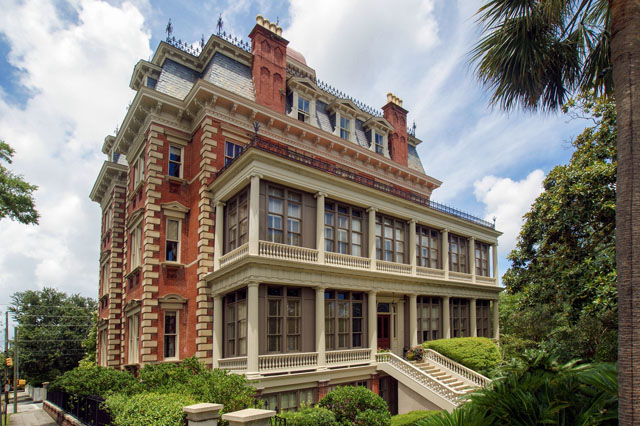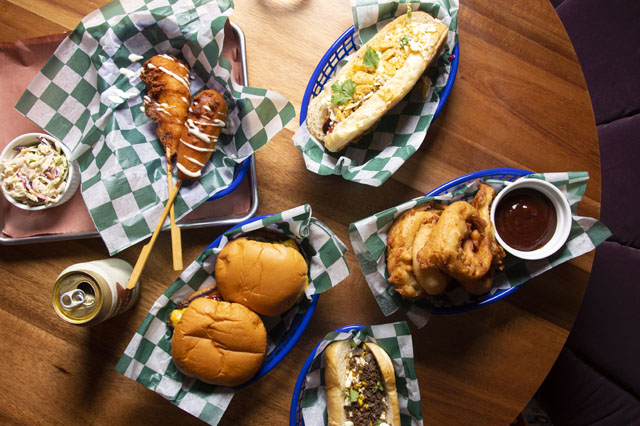A Trip Through Time
06 Sep 2023
History & architecture abound at storied Charleston hotels
By Tatum Jacaruso
Charleston has long been dedicated to preserving its historic architecture. With details like wrought iron fences, piazzas and secret gardens, the city looks and feels like a time capsule of centuries past. These details reflect numerous architectural styles throughout the city including Colonial, Federal, Classic Revival, Gothic Revival, Italianate, Georgian, Beaux-Arts, Queen Anne, Art Deco, and Victorian—many of which were inspired by cultures from across the globe.
Colonial architecture was popular during the Colonial period in American history from the 1600s to the 1700s and features Spanish, English and French influences. This simple style can be seen in the Old Exchange and Provost Dungeon on East Bay Street downtown. Victorian architecture, which was popular in the mid-1800s to 1900 and named after Queen Victoria, often features turrets and towers and iron railings. An example is the Sottile House on the College of Charleston campus. Gothic Revival can be seen in the French Huguenot Church at 136 Church Street and includes details like scalloping, pinnacles and pointed windows.
These styles permeate life in the Holy City, from families relaxing on the porch of their Charleston single house, to light shining through stained glass windows at church on Sunday. Historic hotels also embody the architecture of Charleston’s past, notably the Second Empire style of Wentworth Mansion and the Beaux-Arts style of the Francis Marion Hotel. These hotels have taken strides to preserve their original designs and are part of downtown’s historic charm.

Wentworth Mansion
On the corner of Wentworth and Smith streets is Wentworth Mansion, dating back to the 1880s. This four-story, 24,000-square-foot home was built for Francis Silas Rodgers, a wealthy cotton merchant and was completed in 1886. It was designed by renowned architect Daniel G. Wayne in a Second Empire style, which was most prevalent in the late nineteenth and early twentieth century. The mansion is considered the best example of this style in Charleston. One of the style’s key characteristics is the Mansard roof, which features a steep lower slope, flatter upper slope, and dormer windows and dates back to seventeenth century France.
“You can absolutely feel the history and grandeur of the mansion,” said Stacey Bodnar, director of marketing and public relations for Charming Inns of Charleston, which includes the Wentworth Mansion. This luxury hotel features several beautiful architectural details that are a link to its past. Among them are two sparkling chandeliers in the Grand Mansion Suite that add to the magic of the place.
“Notably, Rodgers commissioned two grand matching chandeliers during a trip to Europe, which still grace the mansion today,” said Bodnar. “It is said that he (also) brought back their maker to ensure their proper installation.”
The hotel also features carved marble mantelpieces, Tiffany glass panels, Philadelphia-pressed brick, and a rooftop cupola with panoramic views of the city. The cupola, or small dome, is an iconic feature of Wentworth Mansion.
“Francis Silas Rodgers used to spend hours in this elevated space searching for signs of smoke that could indicate a fire in the city,” said Bodnar. Today, guests enjoy pink sunsets and views of the Ashley and Cooper Rivers from this special viewpoint.
Wentworth Mansion withstood the 1886 earthquake and changed hands a few times before being acquired by its current owner in 1997. The hotel then underwent a $7 million restoration project preserving architectural details including the inlaid floors, original staircase and Tiffany glass. Today, the hotel boasts 21 rooms, a spa, and a fine dining restaurant. The former stable building became the Spa at Wentworth Mansion. The carriage house, which once housed stables and carriages, was transformed into Circa 1886 restaurant featuring original pine floors and à la carte and tasting menus.
Bodnar said that the hotel is a living testament to all of the effort that went into its design and creation over 100 years ago.
“We look forward to continuing to welcome guests from around the world who can share in our beautiful gem. We are honored to be the caretakers of such a wonderfully historic property,” said Bodnar.

The Francis Marion Hotel
The Francis Marion Hotel is situated at the corner of King and Calhoun streets in the Radcliffeborough neighborhood. The hotel first opened on February 7, 1924, during the Charleston Renaissance. This movement of art, music, dance, writing and history that took place between the two world wars saw a renewed interest in protecting local architecture. In 1931, the country’s first preservation ordinance was passed in Charleston and the Board of Architectural Review was established. Since opening during this renaissance, the Francis Marion Hotel has made ongoing efforts to preserve its past.
The hotel was named for General Francis Marion of the Revolutionary War, nicknamed the “Swamp Fox” for his ability to hide from the British in the swamps. The structure was built by New York architect William Lee Stoddart and was the largest hotel in South Carolina at the time, as well as the first to have air conditioning and private bathrooms. The original Francis Marion Hotel also had a barbershop on the club level as well as an ice-making plant and a printing press where the spa is now. At 12 stories, it was the tallest building in the city, rising higher than the church steeples with sweeping views of downtown and the Charleston Harbor. While it’s no longer the tallest building in town, the Francis Marion still has iconic views of the Holy City and the harbor.
“When you step into our lobby, it's like stepping back into time. And I think that historical ambiance is our biggest selling point,” said Brandi Sanichar, corporate social media and marketing manager at the Francis Marion Hotel. “Travelers select Charleston for the history and the Francis Marion Hotel is one of just a few historic hotels in the Charleston area.”
The building features Beaux Arts-style architecture, popular in the late nineteenth century. “Oftentimes we refer to it as a European style, 1920s European style, with the flat roof, the formal design, the ironwork, the crystal chandeliers,” said Sanichar. Beaux Arts buildings are ornate and symmetrical, often incorporating columns and grand entrances. This architectural style was influenced by the French Renaissance as well as Baroque and Neoclassical styles. Other examples of Beaux-Arts buildings are the Charleston Library Society, the Gibbes Museum of Art, and Charleston City Hall.
In 1996, the Francis Marion Hotel underwent a $12 million award-winning restoration project, restoring public spaces and guest rooms. During the renovation, parts of the original hotel were discovered including hidden walls, balconies and hand-strung chandeliers.
“Over the years we've tried to preserve what we can and we are almost 100 years old, so things need fixing,” said Sanichar. From 2022 to the spring of this year, the hotel underwent a scaffolding project on the exterior, repairing the bricks and replacing the mortar and terracotta on the King Street and Calhoun Street sides. Today, the hotel accommodates 234 guests and offers three beautiful ballrooms and a spa. Swamp Fox Restaurant—also named for General Francis Marion—serves classic Lowcountry fare like shrimp and grits and biscuits and gravy.
This local landmark plans to continue its preservation efforts with additional renovations in the next couple of months, restoring the exterior of the hotel facing St. Philip Street. Coming up on its one hundredth anniversary in 2024, the hotel is planning a grand celebration to commemorate the milestone. “Charleston has been a top destination for many years,” said Sanichar. “The Francis Marion Hotel is grateful to have been a part of the blossoming historic city for nearly a century.”











